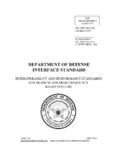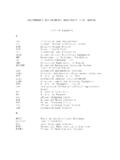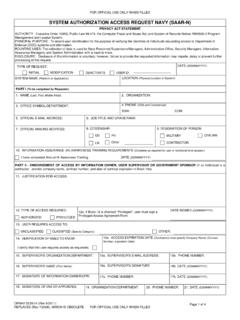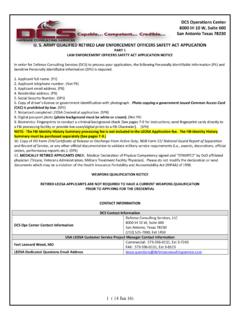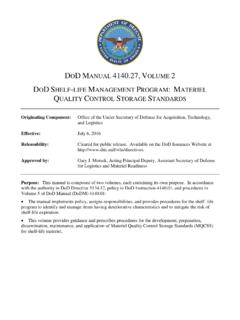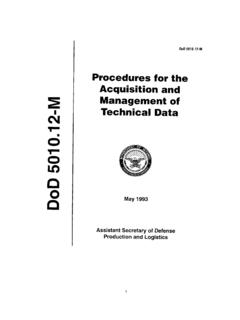Transcription of BY ORDER OF THE SECRETARY AIR FORCE …
1 BY ORDER OF THE SECRETARY OF THE AIRFORCE AIR FORCE INSTRUCTION 10-712 17 DECEMBER 2015 Operations CYBERSPACE DEFENSE ANALYSIS (CDA) OPERATIONS AND notice AND CONSENT PROCESS COMPLIANCE WITH THIS PUBLICATION IS MANDATORY ACCESSIBILITY: Publications and forms are available for downloading or ordering on the e- Publishing website at RELEASABILITY: There are no releasability restrictions on this publication OPR: AF/A3OY Supersedes: AFI10-712, 8 June 2011 Certified by: HQ USAF/A35 (Maj Gen Martin Whelan) Pages: 47 This publication implements Air FORCE Policy Directive (AFPD) 10-7, Information Operations. It also implements the guidance in Department of Defense Instruction (DODI) , Communications Security (COMSEC) monitoring and Information Assurance (IA) Readiness Testing and is consistent with the policy established in AFPD 33-2, Information Assurance. It provides responsibilities, procedures, and guidance for the Air FORCE s Cyberspace Defense Analysis (CDA) Operations and notice and Consent Process.
2 It conforms to national and Department of Defense (DOD) directives pertaining to the monitoring of unsecure electronic communication for information content. It applies to individuals at all levels including the Air FORCE Reserve and Air National Guard (ANG), except where otherwise noted, who use Air FORCE controlled DOD electronic communication systems, equipment, and devices and to those who operate, connect, or interact with information systems owned, maintained, and controlled by the DOD. This includes all information technology used to process, store, display, transmit, or protect DOD information, regardless of classification or sensitivity. The authorities to waive wing/unit level requirements in this publication are identified with a Tier ( T-0, T-1, T-2, or T-3) number following the compliance statement. See AFI 33-360, Publications and Forms Management, Table for a description of the authorities associated with the Tier numbers.
3 Submit requests for waivers through the chain of command to the appropriate Tier waiver approval authority, or alternately, to the Publication OPR for non-tiered compliance items. This publication may be supplemented at any level, but all supplements must be routed to the Office of Primary Responsibility (OPR) listed above for coordination prior to certification and approval. Refer recommended changes and questions about this publication to the OPR listed above using the AF Form 847, Recommendation for Change of Publication; route AF Forms 847 from the 2 AFI10-712 17 DECEMBER 2015 field through the appropriate chain of command. Requests for waivers must be submitted to the OPR listed above, or as otherwise stipulated within this publication, for consideration and approval. Ensure that all records created as a result of processes prescribed in this publication are maintained in accordance with Air FORCE Manual (AFMAN) 33-363, Management of Records, and disposed of in accordance with Air FORCE Records Information Management System (AFRIMS) Records Disposition Schedule (RDS).
4 The use of the name or mark of any specific manufacturer, commercial product, commodity, or service in this publication does not imply endorsement by the Air FORCE . SUMMARY OF CHANGES The publication has been revised. This rewrite of AFI 10-712 includes the introduction of the CDA weapon system (WS) with its three mission sets; the title change from Telecommunication Monitoring Assessment Program (TMAP) to CDA Operations and notice and Consent Process; and identifies tiered waiver authorities for unit level compliance items IAW AFI 33-360, Publications and Forms Management. Changes to this document include the roles for MAJCOM, DRU, and FOA Operations Security (OPSEC) Program Managers (PM), expanded explanation of the CDA WS products and procedures, updates to the notice and consent procedures and timelines. Chapter 1 GENERAL 4 Overview.
5 4 4 CDA Authority.. 4 Figure Cyberspace Defense Analysis Mission 6 notice and Consent.. 7 Roles and Responsibilities.. 8 Chapter 2 DISTRIBUTION OF ESSA PRODUCTS 18 Focused Look Assessment Request Procedures.. 18 Figure CDA Mission Request Process Flow .. 19 Distribution of ESSA Products.. 19 ESSA Products.. 20 Types of ESSA Products.. 20 Chapter 3 ESSA ATTRIBUTION AND UNIQUE REPORTING 23 Release of ESSA Information.. 23 AFI10-712 17 DECEMBER 2015 3 Use and Control of ESSA Products; Situational Guidance.. 23 Assessment Preparation.. 25 Team Travel and Funding.. 25 Quality Control (QC).. 26 Chapter 4 notice AND CONSENT PROCEDURES 27 Notification.. 27 Telephone Directories.. 27 Telephones.. 27 Facsimile Machines and Multi-Function Devices.. 27 Information Systems.. 28 Private or Intranet Web Home pages.. 28 Portable Electronic Devices (PED).
6 28 Other Information Technology.. 29 Optional notice and Consent Awareness Methods.. 29 notice and Consent Certification Process.. 29 notice and Consent Certification Schedule.. 32 Table notice and Consent Certification Schedule .. 32 Attachment 1 GLOSSARY OF REFERENCES AND SUPPORTING INFORMATION 34 Attachment 2 STANDARD MANDATORY DOD notice AND CONSENT BANNER 39 Attachment 3 MANDATORY notice AND CONSENT PROVISION FOR ALL DOD INFORMATION SYSTEM USER AGREEMENTS 40 Attachment 4 notice AND CONSENT MEMORANDUM WITH 1ST AND 2ND IND 42 Attachment 5 notice AND CONSENT CHECKLIST 45 4 AFI10-712 17 DECEMBER 2015 Chapter 1 GENERAL Overview. The Air FORCE (AF) uses electronic communications systems such as telephones, cellular phones, radios, pagers, computers, computer networks, internet-based capabilities (IbC) such as blogs, web-sites, social networking sites, etc.
7 , and other wired or wireless electronic devices to conduct day-to-day official business. Adversaries can easily monitor these systems to gather information regarding military capabilities, limitations, intentions, and activities. Electronic System Security Assessment (ESSA) provides commanders with an assessment as to the type and amount of information traversing Department of Defense (DOD) electronic communication systems that is at risk to adversary collection and exploitation. ESSA products can be used to evaluate personnel compliance with Information, Personnel, and Industrial Security practices; Communications Security (COMSEC) and Cybersecurity procedures, and the implementation of Military Deception, and Operations Security (OPSEC) activities. ESSA products are also used to support other security operations, activities, and programs to enhance FORCE protection, and focus training requirements.
8 Purpose. The Air FORCE conducts ESSAs using the CDA WS to support OPSEC analysis of protection measures for AF Core Functions. ESSA monitoring involves the collection and analysis of information transmitted via DOD electronic communication systems. These systems can include radios, wired or wireless telephones, and computer networks. ESSA products help commanders evaluate their organization's Information, Personnel and Industrial Security practices; COMSEC, Wing Cybersecurity office, and OPSEC posture by determining the amount and type of information available to adversary collection entities. The AF monitors, collects, and analyzes information from DOD electronic communications systems to determine if any critical or classified information transmitted via unsecured and unprotected systems could adversely affect US (and allied/coalition) operations.
9 CDA operations are an integral part of AF OPSEC, Information Operations (IO), and Red Teaming. It is a very effective tool to identify real world problems that can adversely affect the warfighter s effectiveness. During assessments, items such as stereotyped patterns or administrative, technical, and physical security procedures routinely surface as possible sources of intelligence losses. CDA Authority. Headquarters Air FORCE Space Command (HQ AFSPC) CDA elements (including its gained or associated reserve units) are the only AF organizations authorized to conduct CDA activities. These activities are accomplished within certain legal parameters utilizing authorized tools to monitor, collect, and transfer telecommunication data for analysis. They perform CDA activities in a manner that satisfies the legitimate needs of the AF to provide OPSEC assessments while protecting the legal rights and civil liberties of those persons whose communications are subject to CDA monitoring.
10 The authority to monitor AF networks in the course of network defense is derived from the service provider exceptions to the Electronic Communications Privacy Act, 18 USC 2111(2)(a)(i) and 18 USC 3121(b)(1); the 2008 National Security Presidential Directive-54/Homeland Security Presidential Directive-23 (NSPD-54/HSPD-23), which directed AFI10-712 17 DECEMBER 2015 5 initiatives to monitor Federal information systems for network security purposes; the National Defense Authorization Act (NDAA) Section 931, codified as a note to 10 USC 2223, NDAA 2012, Section 953; Department of Defense Directive (DODD) , Computer Network Defense, and DOD Instruction (DODI) , Cybersecurity. CDA Missions: The CDA WS currently conducts three separate missions: Active Indicator Monitoring (AIM) in support of cyberspace network defense and ESSA in support of OPSEC mission sets and Cyberspace Operations Risk Assessment (CORA) in support of Cybersecurity.










